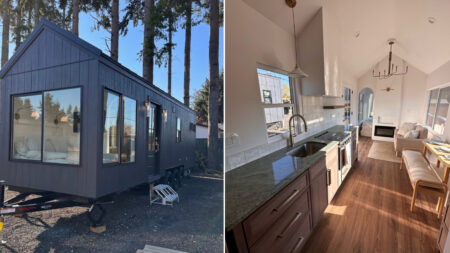Airstream had discovered its uber-rich. Caravans had found their hippies. The capitalists had identified a new market. Yet, laws in America forbade tiny houses. Bypassing zoning and building codes was a challenge. Harsh weather and inadequate insulation added further complications for an alternative housing solution. But Jay Shafer was up and willing to take the challenge!
Many, back then, lacked the construction skills to build their own homes. Thus, the momentum seemed to have again shifted toward conventional housing. The tiny houses – whatever little had been constructed – were on the brink of dying a slow death. Jay Shafer took the reigns in his hands to emerge as a key figure in catapulting the movement that would remember his contribution forever.
After years of effort, numerous design iterations, and the establishment of the first-ever tiny house on wheels, along with the inception of Tumbleweed Tiny Houses (the first tiny house company), Jay Shafer’s Tiny House Movement was ready to storm the housing market forever.
Over the years hence the world witnessed soaring sales for micro dwellings. What began as a fad, evolved into a full-fledged movement, but Shafer was nowhere to be seen…

Today, when the tiny house movement is at its pinnacle, I touch base with the pioneer of the tiny house movement to delve into the origins, challenges, and future of the phenomenon that has redefined modern living spaces.
As I delved deep into the conversation, I found Jay Shafer’s tiny house story is not just about a home on wheels that features ‘Sacred Geometry’ and ‘high-end insulation’, it is also a saga of a stained relationship with Tumbleweed, the company he had once founded.
“Whenever the tiny house movement will go down in the annals of history if there would be one name etched in golden words, it’ll be yours. How does it feel to be called a pioneer of the tiny house movement or the father of the tiny house movement,” I asked Jay.
He graciously replied, “I love it. It makes me feel important. Like, I’ve done something. Thank you for calling me that. Some people call me the grandfather of the movement and I prefer godfather or pioneer. Makes me feel younger!”
Shafer then goes on to reflect on the inception of his dream to build a tiny house.
“Nothing comes out of nothing. So there were certainly some inspirations. I had seen a book by a guy named Lester Walker. He wrote the book, tiny houses way back. I was inspired by all these little structures that were in there. I looked up tiny houses in some other places and it turns out laws in America forbid tiny houses. So when I learned that they were illegal, I just had to do it and show that tiny house is safe and efficient and really should be the standard for housing in general.”
Before embarking on his tiny house journey, Shafer was an adjunct professor teaching drawing at the University of Iowa. He also worked in a grocery store, allowing him the flexibility to design and build his house. “I had been living in an airstream for two years before building my first house. And that was sort of my experiment. Like, what do I need? What do I not need? I decided I needed far more insulation, at least in Iowa, which is where I was at the time.” Living in a 14-foot airstream became an experimental precursor, shaping his understanding of necessities and insulation needs.
Jay started building his first tiny house in 1997 and completed it by the summer of 1999. His home was the size of a miniature country chapel that boasted weathered wood in its exterior and interior. The structure was then capped by a high-pitched roof that offered him both shelter and protection from adverse weather. He had crimson-trimmed windows maintaining airflow and also squeezed in a mattress for sleeping.
“To me, the beauty is very important. I’m always sticking with what might be called ‘sacred geometry’. Sacred geometry is just when you assign meaning to each number and form. I figure, if you’re going with less quantity, you go with a lot of quality. That isn’t universal throughout the tiny home industry. There are a lot of great houses out there, but also a lot of people just cranking out houses because they realize there is a demand,” he states.

Jay then admits that the reaction of the people toward tiny houses was invariably positive from the beginning. “They were very excited by the little house I had built and they loved the idea. I got it into a magazine that was doing a contest, and went on to win the contest for the most innovative house of the year,” he proudly states.
“With so much obscurity surrounding micro dwellings, how would you define a tiny house on wheels?
He clarifies, “Well, I’ve always tried to stick with the definition I had from the beginning, which was that any house in which all the space is used and nothing is wasted is a tiny house. So that could be any house. Now a tiny house on wheels would have to meet the road requirements unless you want to get into some weird bureaucracy of moving bridges and power lines. So that would be probably 400 square feet (37.16 m²) or less in the United States. And definitely no taller than bridges are.”

Shafer then sheds light on Tumbleweed Tiny House Company and his collaboration with Steve Weissman (CEO of Tumbleweed Tiny House). “I started Tumbleweed back in Iowa when I finished building my first house. I pretty much-launched pictures of my house and the story of my house and the business all at one time, along with a book I’d written on the subject, and a few years later I hooked up with Steve Weissman because he seemed to be a business-minded person. I am definitely not. So, I was looking for somebody to take care of that end of things.”
Just when the tiny house movement was peaking and Tumbleweed was extensively popular, things went south with the two co-founders. “We had different views of what should be going on in the company and the messaging and whatnot. So I split, I took off, put my own way, and started designing houses elsewhere,” Shafer informs.
After going his own way, Jay decided to found the Four Lights Tiny House Company. So, what everyone thought was the end of the story, was the mere beginning of the bad blood between Jay and Tumbleweed.
“Well, Four Lights still exists in some sort of as some ghost ship. I don’t man that business anymore. It was an attempt to make a better tiny house company. Unfortunately, what happened with that is that Tumbleweed came after us with over a hundred fake lawsuits within a single month. The lawsuits were about things that were nonsensical just to try to shut us down,” he accuses.
Shafer admits, “The legal cost did shut us down. I exited the more visible side of the tiny house world at that point.”
Shafer’s recent passion revolves around addressing zoning and building code challenges. “I am now more focused on the codes, the zoning, and the design. I am gearing up now to open a new business, keep it simple, just sell houses and, and the books I still have sitting around,” he informs.
As a glimpse into the future, Shafer expresses excitement about the concept of tiny house villages. He envisions collaborating with cities and counties to provide efficient and affordable housing solutions. From challenging the legality of tiny houses to envisioning a future with collaborative tiny house villages, Shafer’s journey not only offers a fascinating insight into the evolution of the movement but also narrates the story of a man whose influence extends far beyond the walls of his tiny homes.
Follow Homecrux on Google News!





Well if it makes him feel any better, Steve Weissmann has pretty much run the company into the ground and he’s about to go into bankruptcy for the second time.